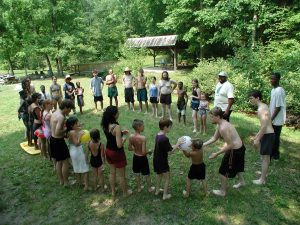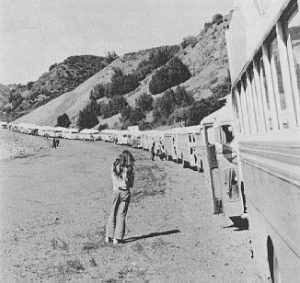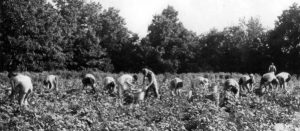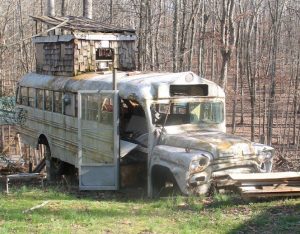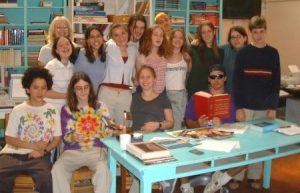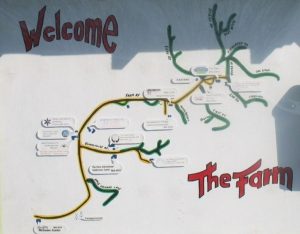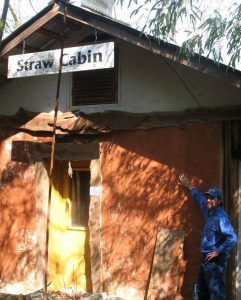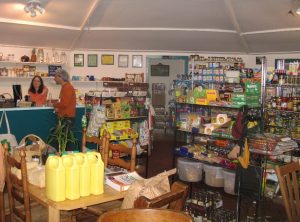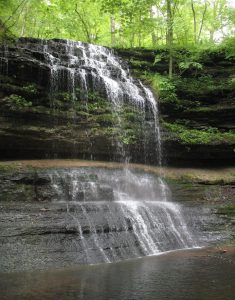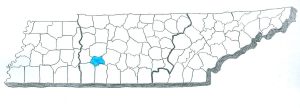In 1970 a group of around 300 young people left San Francisco in a caravan of school buses and traveled across the country looking for a place to call home. Because of their clothing, hair length and lifestyle, these young people were regarded by many people as hippies — and the “hippie caravan” made big news.
After a journey across America, they settled in Lewis County, Tennessee, and started their community, which they referred to as “The Farm.” For the next few years it was mentioned in books, newspapers and television news shows as the “largest” and “best known” commune in America. At “The Farm,” everyone was welcome, given a place to sleep and food to eat. But they were also given a job to do, and if they didn’t want to work, they were asked to move on.
In terms of Tennessee places, The Farm is in some ways comparable to Rugby; the Cumberland Homesteads or Ruskin — all attempts by people to build a community based on different rules. But there is one big difference between The Farm and the other three places (which were all shortlived). Founded in 1971, The Farm still exists, though under a different setup than first established. Today its residents refer to it as an “intentional community,” and life on The Farm is still different than anywhere else in Tennessee.
At its peak, about 1,200 people lived at The Farm. At that time The Farm was still run as a commune, which means that all possessions and income were held by everyone who lived there. The Farm had a communal dining room, a motor pool, a laundromat and its own crude phone system. The people who lived there became adept at everything from how to fix a car to how to find and install a big water tower.
When The Farm was first created, residents there had to build everything from scratch, including their plumbing system.
But in 1983, The Farm was reorganized. Today the 1750 acres are still owned by the community, but the 170 people who live there have their own things, including their own homes. People who live there either work at outside jobs or have employment with one of the many small businesses that operate there.
The Farm also has its own school — a small, K through 12 private school attended by children who live there and some who live nearby. In typical Farm fashion, it was built with an environmentally friendly design — with huge south-facing windows that maximize solar heat in the winter.
The Farm School also reminds us that, over the years, hundreds of children have grown up at The Farm. During its days as a commune, The Farm unofficially “adopted” many children; in fact, The Farm had a general policy of accepting all babies, children and teenagers who were left at its doorstep.
So what’s there to see at The Farm? The first thing to point out is that this is not a national park or a museum. In some ways, coming to The Farm is like visiting any other small community — most of the time, people are just minding their own business (unless you visit during a so-called Farm Experience Weekend — click here to learn more about this.) Nevertheless, The Farm does have a few things that other small communities don’t have. Since the entire place is private property, it has a gate and visitor’s center, where we were greeted by a friendly woman named Vicki.
Once you are admitted to The Farm, you might enjoy a trip to the Farm Store, which sells some health food items you might be surprised to find at a place so remote. Beside the store, you’ll find a structure unlike any you’ve ever seen — a steel dome that towers over a small playground. In the early 1980s people who worked at The Farm moved this steel from abandoned buildings throughout the surrounding counties and welded this structure together. We were told that they never quite finished it, but it looks impressive nonetheless.
Keep your eyes pealed while you move around The Farm, because there’s a lot more than you might realize. Among the more interesting operations at The Farm today are a radio station, a dairy that produces soy milk (click here to see where you can buy it), a book publishing company and a midwifery operation (where women come to deliver babies). In fact, the advancement of midwifery as an accepted practice is one of The Farm’s contributions to Tennessee law; a few years ago, a representative from The Farm successfully lobbied the Tennessee General Assembly to pass a bill recognizing the practice of midwifery.

Plenty volunteers in Central America
serve “ice bean,” which is a desert made
from soybeans
PHOTO: Plenty International
The Farm also serves as headquarters for a few non-profit organizations. The biggest of these is Plenty International, a relief organization started by Farm residents in the 1970s, when a devastating earthquake struck Guatemala. More than 100 volunteers from The Farm went to Guatemala and helped rebuild hundreds of homes, schools and government buildings, passing on much of what they had learned during their experiences at The Farm. Today, Plenty International remains active in countries such as Guatemala, Belize, Mexico and Liberia. And here in Tennessee, Plenty’s “Kids To The Country” program brings children from homeless shelters and refugee centers to the peaceful refuge of The Farm where they have the opportunity to do things like swim, ride horses and pick blueberries.
Also at The Farm you will find the Ecovillage Training Center, where people come from all over the world to learn about alternative building methods and earth-friendly living. Speaking of things you won’t find very often — at the Ecovillage Training Center you will find a house made of straw!
But, in case you are wondering, the one thing that you really won’t find at The Farm anymore is a farm. Although many residents still keep vegetable gardens and tend to a large blueberry patch, the large collective farm on which people worked so hard in the 1970s is long gone. At The Farm, most of the buildings are in the woods. The wide open fields contain a soccer field, a frisbee golf course, and the rest of it is a big nature preserve.
Speaking of nature preserve: Another Farm-related organization is the Swan Conservation Trust. The Swan Conservation Trust has enabled about 1,400 acres next to The Farm to be set aside for hiking and nature loving. This land is very close to Stillhouse Falls — one of the many great waterfalls that you can find on Tennessee’s Highland Rim. So if you come by The Farm, check out the falls!
